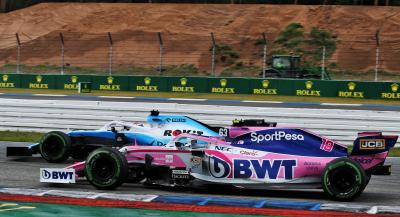Williams: Not having a pink Mercedes is not our weakness
While suspicion has grown within the Formula 1 paddock over bending the rules on copying and constructing major car components, Williams deputy team principal Claire Williams believes all F1 squads are obeying the regulations but its recent slump in results isn’t down to not following the trend.
While suspicion has grown within the Formula 1 paddock over bending the rules on copying and constructing major car components, Williams deputy team principal Claire Williams believes all F1 squads are obeying the regulations but its recent slump in results isn’t down to not following the trend.
Since the arrival of Haas on the F1 grid and its model of coordinating with Dallara to manufacturer its car chassis, along with a close technical partnership with Ferrari on the power unit side, all eyes were on Racing Point during 2020 pre-season testing as it unveiled a remarkably similar design to Mercedes’ world title-winning W10 from 2019.
While Racing Point dismissed claims its RP20 is an outright copy, explaining it had altered its design philosophy for 2020 thanks to his greater resources from its new ownership led by Lawrence Stroll, it continues a growing trend of teams pooling resources and producing similar cars – a tactic Red Bull and AlphaTauri has adopted for a number of years when it is permitted within the rules.
The Williams team leader says she had no major problem with the “different business model” but insists it isn’t a plan her squad will follow given its history and previous success as a fully-fledged constructor.
“I think that they’re operating within the regulations, so they’re entitled to do that, that’s their choice,” Williams said about Racing Point and Haas. “They have a very different set-up to that which we have. We have a full manufacturing and operations department within the team, and you know I don’t have any inclination to change that.
“They don’t have that capacity, they don’t have that bandwidth, so it makes sense for them as a business. We all have very different business models up and down the pit lane, and they all work for you as they do and you make those choices.
“So we’ve been successful with the business model that we have just in the recent past. We were very successful in ‘14, ‘15, ‘16 and ‘17. It’s just the past two years. It’s not because we don’t have a Mercedes that is coloured pink that we’re not doing very well.”
Key to Williams’ drop in performances and results over the previous two seasons has been its struggles in producing a competitive car amid poor design which has created slow or inconsistent developments relative to its F1 rivals.
Where Williams’s frustrations remain are on the current F1 rules in the “two-tier championship” which has evolved, with the top three teams Mercedes, Ferrari and Red Bull using the biggest operations and budget to keep hold of a vast performance edge over the rest of the F1 field.
Williams hopes the incoming F1 team cost cap will help reduce the gap between all teams by limiting spending while also stopping smaller teams from overspending.
“I think we need to create a sustainable sport for all of the teams. The work that F1 have done in recent times, particularly around the financial model, has been so important so that we can create sustainability and stability for teams like ours, because all business models should have the right to survive but also thrive in this sport,” she explained.
“We’re not particularly happy with where things are, not least because it creates a two-tier championship, and you want to create a platform whereby every single team in this sport has the opportunity to score points, be on the podium and win races. At the moment we just don’t have that.”









